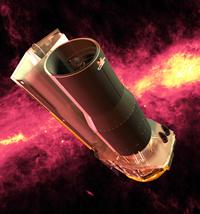 The Spitzer telescope might be seeing the old, distant glow of the Universe’s first stars.© NASA
The Spitzer telescope might be seeing the old, distant glow of the Universe’s first stars.© NASAA faint glow from the first stars in our Universe has been detected, astronomers claim.
"This is probably the first direct indication of their existence," says Alexander Kashlinsky, an astronomer at NASA's Goddard Space Flight Center in Greenbelt, Maryland, and a member of the team that made the discovery.
These earliest stars are known as 'population III' (after young population I stars that look like our Sun, and population II stars, which are older and more rare). They are thought to have formed less than 200 million years after the Big Bang, the fireball of creation that astronomers believe heralded the beginning of our Universe some 13.7 billion years ago.
Astronomers are intrinsically interested in these stars, which are thought to have played the initial role in the long chain of events that led to life as we know it. "These were the stars that first enriched galaxies with the heavier elements that were essential to produce life," says Kashlinsky. Data about these stars might help to confirm or reject theories about how that happened, he adds.
Although they are too distant and old to be imaged directly, their signature should be left behind in the cosmic infrared background radiation, which Kashlinsky describes as, "the repository of emissions for all stellar populations that have ever existed in the Universe".
Using the orbiting Spitzer Space Telescope, the astronomers took a long hard look at the sky to get a high-quality infrared picture. They subtracted the infrared light from all the nearby galaxies and stars, leaving behind a blotchy signal that they ascribe to the telltale clustering of population III stars. The team report their results in this week's Nature1.
Ripples in time
"They're not seeing individual objects," explains Richard Ellis, an astronomer from the California Institute of Technology, Pasadena. "They're looking at ripples in the background radiation."
Ellis is cautious about whether the signal is definitely coming from population III stars. Astronomers have previously tried to peer into the infrared background to see these stars' signatures, but their results suffered from poor resolution and high instrument noise, making it difficult to weed out the signals from nearby galaxies.
"When people have looked for these signals before they found them to be barely in the realm of detectability, but this data looks really clean," says Ellis. "I'm very surprised that the signal is so strong." It is so large, he says, that he wonders whether it might have come from something more than ancient stars.
But Kashlinsky points out that one would expect the signal to be strong, because computer simulations of the early Universe predict that the population III stars were big.
Big and bunchy
"For these stars to have produced a signal this strong, they had to be very massive stars, much bigger than what we see today in the Universe," says Kashlinsky. The stars may have been hundreds of times as massive as our own Sun, burning out in just a few million years and emitting vast amounts of ultraviolet radiation. This ultraviolet light was later stretched out as the Universe expanded, leaving an infrared signature.
Computer simulations also indicate that the stars would be clustered, thanks to quantum fluctuations in the early Universe (see 'Echoes of Big Bang found in galaxies' ).
ADVERTISEMENT
Crucially, Kashlinsky and his colleagues found such clusters that matched at four different wavelengths, in different parts of the sky, and at different times of the year. This helps to rule out any interference from more local sources of infrared light, and chimes with astronomers' best estimates of how the first stars formed.
Ellis says that an independent study by a different group would help to allay his remaining doubts about whether the signals are indeed coming from population III stars. The best evidence would come from being able to pick out individual stars, rather than evidence for their clustering. But that will have to wait until the powerful orbiting James Webb Space Telescope is ready in 2013, he says.
